
table of contents
- Systematics
- Location
- care
- to water
- Fertilize
- Cut
- Wires
- Repot
- Multiply
- Diseases
Profile and care information open +conclude -
- Flower color
- purple, white
- Location
- Partial shade, sunny
- Heyday
- May June
- Growth habit
- upright, spreading, bushy, perennial
- height
- up to 30 meters high
- Soil type
- sandy, loamy
- Soil moisture
- moderately moist, fresh
- PH value
- neutral, slightly acidic
- Limescale tolerance
- Calcium tolerant
- humus
- rich in humus
- Poisonous
- Yes
- Plant families
- Mulberry Family, Moraceae
- Plant species
- Houseplants, Ornamental plants
- Garden style
- Japanese garden, ornamental garden
The Ficus Ginseng can be cultivated well as a bonsai because it is relatively easy to care for. Even beginners in this area will be able to cope with the delicate little tree, and the purchase price is manageable. The small bonsai is very decorative and fits both in the living room and in an office. It is important to adhere to certain care steps with regard to the site conditions and the casting units, so that the owner can enjoy the exotic plant for many years.
Systematics
The ficus ginseng is a subspecies of the fig, whereby the ficus is planted on the root of the ginseng. The fig originally comes from the subtropics, where it can grow to astonishing heights of up to 30 m. These are of course not desired when cultivating as bonsai, but the genetic predispositions are still retained in the small version. The small and distinctive growth form can only be achieved through special cutting techniques and wiring. As a bonsai, the Ficus Ginseng can be kept in room culture all year round.
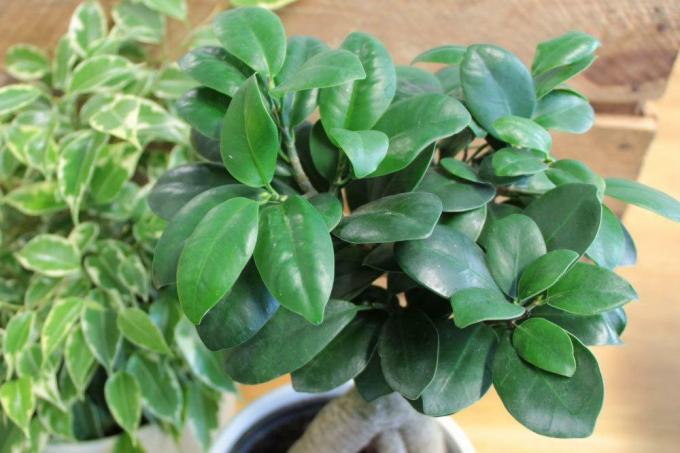
- gnarled and slightly twisted trunk
- forms gray bark
- grows with a broad crown
- forms many evergreen leaves with an oval shape
- not hardy, does not survive winter in temperate latitudes
Location
The Ficus Ginseng is ideally suited as a bonsai for cultivation in living rooms. The bonsai method has been practiced in China and Japan for many millennia. However, traditional tree varieties are used for this, which thrive better in outdoor areas. Due to its calming properties, the delicate wood is often set up in hectic offices. However, the Ficus Ginseng needs a lot of light, the lighter it is, the more numerous the decorative leaves develop. Therefore, choosing the right location is crucial for further development. If this is too cool, there is often an increased loss of the leaves.
- needs a bright location, but without direct sunlight
- protect against blazing midday heat
- at least 5-6 hours of daylight are important
- preferred temperature values of 18-22 ° C
- Avoid cold drafts
- Avoid proximity to the radiator
- Moving outdoors is possible in summer
- From 15 ° C either on the balcony or on the terrace
- Gradual acclimatization to changed lighting conditions
care
Plant substrate
For a successful cultivation of Ficus Ginseng as a bonsai, the quality and composition of the substrate is crucial. Normal garden soil is not enough in this case. The little tree has only a small volume of soil available, so it has to meet its requirements exactly. Only in this way can the root system develop properly. Akadama plays an important role in the professional cultivation of bonsai. These red balls are based on a mineral granulate, which has an excellent ability to store water. At the same time, the Akadama guarantees good air permeability.
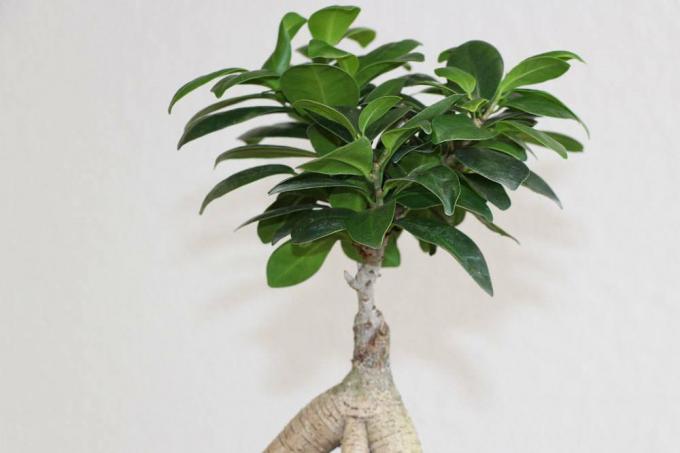
- You can make a suitable plant substrate yourself
- Mix a third of the Akadama, humus and lava gravel
- alternatively to half potting soil and a quarter each of Akadama and pumice
- Another possibility is a mixture of clay, pricking earth and sand
- Place drainage over the water drainage hole
Tip: If you are unsure about the composition of the plant substrate, you can buy special soil for bonsai in specialist shops. This is perfectly tailored to the needs of the ornamental trees.
Planter
The planter is an important part of growing a Ficus Ginseng. Traditionally, stylish bowls are used for this, which visually combine with the bonsai. In specialist shops there is a wide range of special vessels that can be adapted to the cultivation of bonsai. Rectangular bowls with a matching saucer look very elegant. In Japan, moon shells that are formed by hand are often used. Bowls that contain an additional water basin look very distinctive. One part is planted with the bonsai, while the other part contains a small pond. In this way, the required humidity can be increased at the same time.
- Choose according to the growth habit of the bonsai
- about two thirds as long as the ornamental wood grows tall
- Pay attention to muted colors
- brown and gray are ideal so as not to distract from the bonsai
- select matching coasters
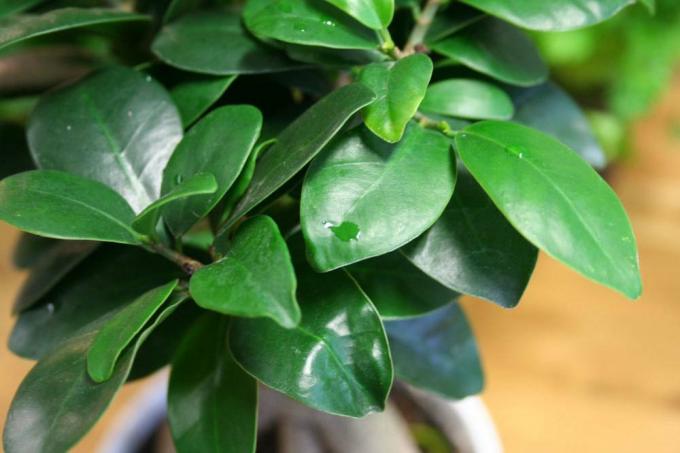
to water
When watering, the correct dosage and the properties of the water are extremely important. In most regions the tap water is too hard and too calcareous for the Ficus Ginseng. Therefore, salt and lime crusts form in the planter. In addition, pouring has to be done with a sure instinct, both in terms of the quantity and the right time for the pouring units. The soil in the pot must never dry out completely. But there must also be no waterlogging, as this damages the ornamental wood in the long term.
- Salt- and lime-free irrigation water is ideal
- collect rainwater if possible
- alternatively use stale tap water
- Check the condition using the finger test
- The surface of the earth should be dry
- Carefully administer the watering water
- Place the humidifier near the plant
- Water more in summer
Tip: During the hot and dry summer months, the Ficus Ginseng should be sprayed periodically with water, and this spray water should also be free of limescale. In this way, the humidity can be increased and the bonsai feels more comfortable.
Fertilize
During the growth phase, the bonsai is happy about additional fertilizers and thanks for this with an increased formation of its deep green leaves. Specialized fertilizers for bonsai are available in specialist shops, but experienced bonsai growers report that conventional liquid fertilizers are sufficient.
- Fertilize from March to September
- Apply liquid fertilizer every 2 weeks
- Dissolve the dose in the watering water
- either fertilizer for Green plants or use bonsai fertilizer
Cut
In order for the Ficus Ginseng to maintain its graceful growth form as a bonsai, specific pruning measures are necessary. The goal when cutting is a strong trunk with many branches. Cuts must be carried out regularly and strategically, after which the ornamental wood is allowed to grow further. In this way, the filigree branching of the plant is promoted. As soon as branches and twigs grow out of the desired shape, they have to be cut off. However, all new shoots must never be removed at the same time, this procedure would extremely weaken the bonsai. Due to the systematic removal of the leaves, the Ficus Ginseng artificially creates an autumn atmosphere. This animates the ornamental wood to sprout smaller leaves. If the pruning is not started often enough, the bonsai will no longer sprout from the old wood.
- Remove dead branches promptly
- regular pruning of the unneeded shoots
- A thick branch must not remain over a thinner branch
- Always start the incision 3 mm above the eye that is directed outwards
- Carry out maintenance pruning from May to September
- Prune about every 5-6 weeks
- as soon as 5-7 new leaves form, cut them back to 2-3
- Leaving the stem standing when cutting the leaf serves to protect the bud
- work towards luscious branches in the crown
- Cut off thicker branches during the winter break
- otherwise too much plant sap escapes, risk of 'bleeding out'
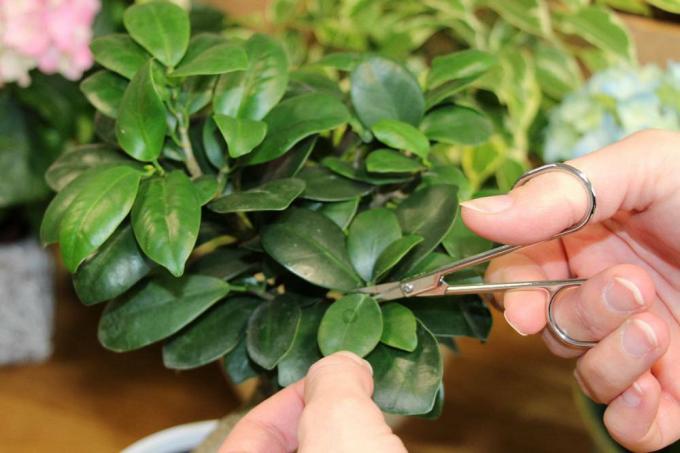
Wires
If the Ficus Ginseng is allowed to grow naturally, then it strives upwards. Regular pruning significantly reduces this urge to grow. However, as an additional trick, the wire is required to achieve the concise shape of the bonsai. Only in this way can the shape in the form of a naturally grown ficus ginseng be achieved. The branches and shoots are used and wired for the spatial bonsai sculpture. This corrective work requires a lot of sensitivity from the bonsai gardener, neither buds nor leaves may be damaged. Bonsai wire from specialist retailers is quite expensive; as an alternative, unused electrical cables can be used and the insulation removed in advance.
- Wires made of aluminum or copper are ideal
- about a third as thick as the branches to be wired
- At the beginning of spring, choose flexible and unwooded twigs and branches
- Wrap the wire loosely at an angle of 45 degrees, from the thick to the thin end
- Remove the wire after a month at the latest
- Check daily whether the wire is already growing into the bark
- in this case remove the wire immediately
- always proceed carefully with the help of a pair of pliers
Repot
After a few years the shell of the Ficus Ginseng becomes too tight. Then the time has come to repot the bonsai. When looking for a new bowl, the length should also be around two thirds of the tree height. This opportunity can also be used to bring the roots into the right shape. The root ball and the crown should finally be in a suitable size ratio to one another. It is extremely important to proceed carefully and carefully so as not to unnecessarily damage the ornamental wood. After repotting and cutting the roots, the Ficus Ginseng is stressed and needs a recovery phase. Therefore, it should not be fertilized, cut or wired for the next four weeks.
- Repot every 2-3 years
- the optimal time for repotting is in spring
- Use a sickle knife to carefully remove the ball of the earth from the edge of the bowl
- Carefully lift the bonsai out of the bowl
- Use the root hook to pull the root ball apart
- Shorten the roots with scissors and / or root tongs
- Let the selected root tips stand
- this is the only way the bonsai can continue to absorb water
- Replace two thirds of the previous plant substrate with fresh soil
- Solidify the new plant substrate with a wooden stick
- there must be no cavities
- Water sufficiently after repotting
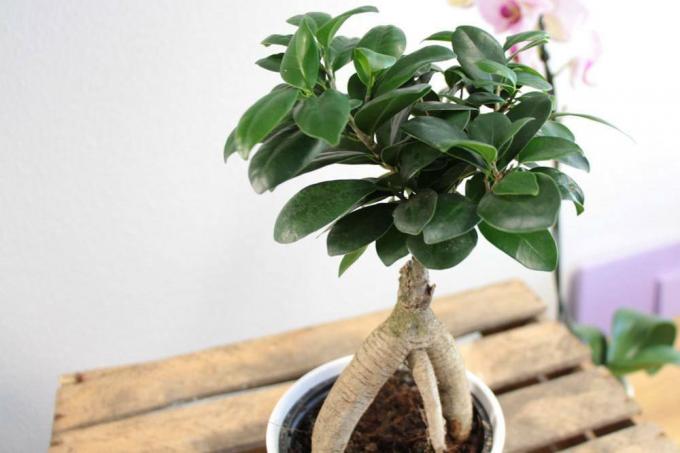
Tools
When cultivating bonsai, having the right tools is crucial. Due to the differences to normal gardening, different and significantly smaller tools are required. These are available from specialist retailers and are a sensible investment. Due to the small size, the conventional garden tools are not so well suited for bonsai cultivation. These can quickly lead to deep cuts and injuries, from which the ornamental wood suffers unnecessarily. The tools prove to be extremely helpful, especially when repotting, and simplify the necessary work steps.
- Pruning saw to remove thick branches and twigs
- sharp leaf cutter to cut leaves correctly
- Brooms to keep the plant substrate in order
- Shovels for the earth
- small scissors to cut off shoots inside the leaf corolla
- Sickle knife to easily loosen the ball of the earth from the shell
- Root hook for loosening the root ball
- Root tongs, for shortening the roots
- Wooden stick to compact the plant substrate
Multiply
The Ficus Ginseng can also be propagated as a bonsai. This is very easy with the help of cuttings. It is important to use a nutrient-poor plant substrate to encourage root growth. In this way, these spread faster in search of suitable food. If the remaining leaves are cut by half, then the cutting needs little energy to supply them and can take care of the formation of new roots. As soon as the cutting has successfully taken root, it forms new leaves. Then the ornamental wood is allowed to move into a larger planting bowl with nutrient-rich bonsai soil. This is then cultivated in the same way as an adult Ficus Ginseng.
- Select and cut only young and strong cuttings
- remove all pairs of leaves except for the two at the top
- Shorten the leaves by half
- Fill the new planter with nutrient-poor plant substrate
- Carefully insert the cutting into the substrate
- Pull the transparent film over the vessel
- Pierce holes for the oxygen supply
- a warm location without direct sunlight is ideal
- Keep the plant substrate evenly moist
- Bring it into the desired shape right from the start
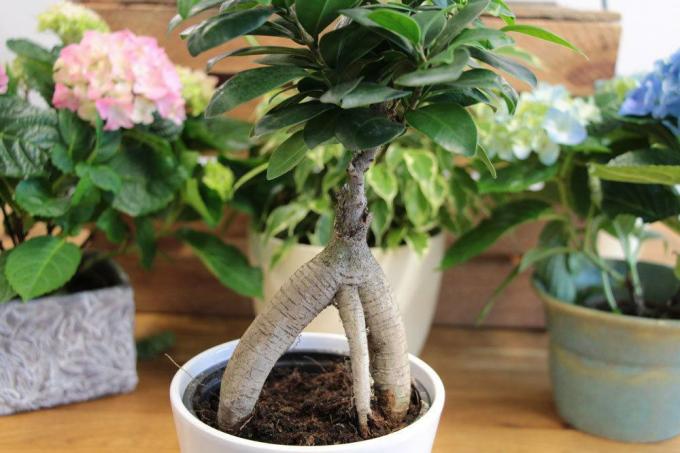
Diseases
Diseases & Pests
Due to its relatively robust properties, Ficus Ginseng is not known to have any diseases or pests. However, mistakes in care can lead to severe leaf loss. When these are corrected, the bonsai will usually recover and regain its beautiful leaves.
Common grooming mistakes include:
- wrong location with constant lack of light
- missing nutrients due to inadequate plant substrate
- too cold temperature values
- permanent waterlogging
- too dry root ball
- cold drafts
- air that is too dry for a long time



